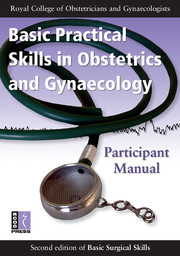Introduction to the course
Published online by Cambridge University Press: 05 July 2014
Summary
This handbook has been prepared for participants on the Royal College of Obstetricians and Gynaecologists' Basic Practical Skills in Obstetrics and Gynaecology course. The course has been designed to introduce trainees to safe surgical techniques and obstetric clinical skills in a structured workshop environment.
It is a requirement that this course is completed during ST1/2 before trainees move to ST3. The course consists of three modules and covers basic surgical skills and basic skills in obstetrics. In each module, the importance of sound knowledge of anatomy, the correct development of tissue planes, the appropriate use of traction and counter-traction, the need to obtain meticulous haemostasis and the importance of gentle tissue handling will be emphasised. In addition, the trainees will be taken through basic obstetrics skills and will have the opportunity to practice these skills under direct supervision.
The course runs from a number of approved regional centres and is standardised to ensure that common objectives, content structure and assessment methods are followed. The contents of the course do not represent the only safe way to perform a procedure but endeavour to give trainees one safe approach to common obstetric and gynaecological procedures. There is an emphasis on acquiring practical skills.
Each course will include:
□ considerable hands-on practical experience
□ high tutor to participant ratio
□ course manual
□ performance assessment with feedback to identify strengths and weaknesses.
- Type
- Chapter
- Information
- Basic Practical Skills in Obstetrics and GynaecologyParticipant Manual, pp. 1 - 2Publisher: Cambridge University PressPrint publication year: 2010



